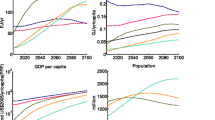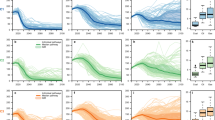Abstract
In recent years the world has moved to a new path of rapid global growth, largely driven by the developing countries, which is energy intensive and heavily reliant on the use of coal—global coal use will rise by nearly 60% over the decade to 2010. It is likely that, without changes to the policies in place in 2006, global CO2 emissions from fuel combustion would nearly double their 2000 level by 2020 and would continue to rise beyond 2030. Neither the SRES marker scenarios nor the reference cases assembled in recent studies using integrated assessment models capture this abrupt shift to rapid growth based on fossil fuels, centred in key Asian countries. While policy changes must and will occur, the realism of the reference case is critical for analysis and policy formulation. Using such a reference path will have significant effects on impact and damage estimates, on the analysis of achievable stabilisation paths and on estimates of the costs of achieving stabilisation at a given GHG concentration level. Use of a realistic reference path is also essential for the international negotiations, arising out of the COP13 meeting in Bali, to achieve widely desired stabilisation goals: both the level of emission reductions to be achieved, and the preferred distribution of those reductions over countries and regions, will be heavily influenced by the reference case assumed.
Similar content being viewed by others
References
Andrews-Speed P (2004) Energy policy and regulation in China. Kluwer Law International, The Hague
Berk MM, den Elzen MJ (2001) Options for differentiation of future commitments in climate policy: how to realise timely participation to meet stringent climate goals. Climate Policy 1:465–480
Blanchard O et al (2003) Efficiency with equity: a pragmatic approach. In: Kaul I, Conceição P, Le Goulven K, Mendoza RU (eds) Providing public goods: managing globalization. Oxford University Press, Oxford
Böhringer C, Löschel A (2005) Climate policy beyond Kyoto: Quo vadis? A computable general equlibrium analysis based on expert judgements. Kyklos 58(4):467–493
Böhringer C, Welsch H (2006) Burden sharing in a greenhouse: egalitarianism and sovereignty reconciled. Appl Econ 38:981–996
Bollen JC, Manders AJG, Veenendaal PJJ (2004) How much does a 30% emission reduction cost? Macroeconomic effects of post-Kyoto climate policy in 2020. CPB Document no 64. Netherlands Bureau for Economic Policy Analysis, The Hague
British Petroleum (BP) (2003) Statistical review of world energy 2003. British Petroleum, London
British Petroleum (BP) (2007) Statistical review of world energy 2007. British Petroleum, London
Castles I, Henderson D (2003) The IPCC emission scenarios: an economic–statistical critique. Energy Environ 14(2–3):159–185
Chinese Academy of Social Sciences (CASS) (2007) Understanding China’s energy policy: economic growth and energy use, fuel diversity, energy/carbon intensity and international cooperation. Background paper prepared for Stern Review on the Economics of Climate Change. Research Centre for Sustainable Development, CASS, Beijing
Clarke L et al (2007) Scenarios of greenhouse gas emissions and atmospheric concentrations@ Sub-report 2.1A of Synthesis and Assessment Product 2.1, U.S. Climate Change Science Program and the Subcommittee on Global Change Research Department of Energy, Office of Biological and Environmental Research, Washington, DC
Criqui P, Kourvaritakis N (2000) World energy projections to 2030. Int J Glob Energy Issues 14:116–136
Criqui P et al (2003) Greenhouse gas reduction pathways in the UNFCCC process up to 2025. Technical Report Study Contract B4-3040/2001/325703/MAR/E1 for the European Commission, DG Environment, Brussels
Dai Y, Zhu Y (2005) China’s energy demand scenarios to 2020: impact analysis of policy options on China’s future energy demand. Int J Glob Energy 24(3/4):131–143
den Elzen MGJ, Lucas P (2005) The FAIR model: a tool to analyse environmental and costs implications of climate regimes. Environ Model Assess 10(2):115–134
den Elzen MGJ, Meinshausen M (2005) Meeting the EU 2°C climate target: global and regional emission implications. MNP Report 728001031/2005. Netherlands Environmental Assessment Agency (MNP), Bilthoven, The Netherlands
den Elzen MGJ, Meinshausen M (2006) Multi-gas emission pathways for meeting the EU 2°C climate target. In: Schellnhuber HJ et al (ed) Avoiding dangerous climate change. Cambridge University Press, Cambridge
den Elzen MGJ, Lucas P, Van Vuuren DP (2005) Abatement costs of post-Kyoto climate regimes. Energy Policy 33(16):2138–2151
Department of Energy US (DOE) (2001/2007) International energy outlook. Department of Energy US, Washington, DC
Garbaccio RF, Ho MS, Jorgenson DW (1999) Why has the energy-output ratio fallen in China? Energy J 20(3):63–91
Groenenberg H, Blok K, Van der Sluijs J (2004) Global Triptych: a bottom-up approach for the differentiation of commitments under the Climate Convention. Climate Policy 4(4):153–175
Hansen J et al (2000) Global warming in the twenty-first century: an alternative scenario. Proc Natl Acad Sci 97(18):9875–9880
Höhne N et al (2005) Options for the second commitment period of the Kyoto Protocol. Federal Environment Agency, Berlin
Höhne N (2006) What is next after the Kyoto Protocol: assessment of options for international climate policy post 2012. Techne, Amsterdam
Intergovernmental Panel on Climate Change (IPCC) (2007) Climate change 2007: mitigation. Contribution of Working Group III to the Fourth Assessment Report of the Intergovernmental Panel on Climate Change. Cambridge University Press, Cambridge
International Energy Agency (IEA) (2006a) World energy statistics and balances, and CO2 emissions from fuel combustion. Paris. http://data.iea.org/ieastore/statslisting.asp. Cited 23 July 2007
IEA (2006b) World energy outlook 2006. IEA, Paris
IEA (2007) World energy outlook 2007. IEA, Paris
International Monetary Fund (IMF) (various years to 2007) World economic outlook. Washington DC
Lin X, Polenske KR (1995) Input–output anatomy of China’s energy use changes in the 1980s. Econ Syst Res 7(1):67–84
Meinshausen M (2006) What does a 2°C target mean for greenhouse gas concentrations? A brief analysis based on multi-gas emission pathways and several climate sensitivity uncertainty estimates. In: Schellnhuber H et al (ed) Avoiding dangerous climate change. Cambridge University Press, Cambridge
Meinshausen M et al (2006) Multi-gas emissions pathways to meet climate targets. Clim Change 75(1–2):151–194
Michaelowa A, Tangen K, Hasselknippe H (2005) Issues and options for the post-2012 climate architecture: an overview. International Environmental Agreements 5(1):5–24
Nakiçenovic N, Swart R (eds) (2000) Special report on emissions scenarios. Cambridge University Press, Cambridge
Nakiçenovic N et al (2003) IPCC SRES revisited: a response. Energy Environ 14(2–3):187–214
National Bureau Statistics China (NBSC) (2007a) Statistical communiqué on the 2006 national economic and social development. 28 February. Beijing. http://www.stats.gov.cn/english/newsandcomingevents/t20070301_402388091.htm. Cited 23 July 2007
NBSC (2007b) National economy kept steady and fast growth in the first half of 2007. 19 July. Beijing. http://www.stats.gov.cn/english/newsandcomingevents/t20070719_402418974.htm. Cited 24 July 2007
NBSC (2007c) Value-added of industry expanded in the first half year. 23 July, Beijing
National Development Research Centre (NDRC) (2004) China national energy strategy and policy to 2020. Subtitle 2: scenario analysis on energy demand. Beijing. http://www.efchina.org/documents/2_Energy_scenarios.pdf. Cited 1 June 2006
Parikh KS (2006) Integrated energy policy: report of the expert committee. Planning Commission, Government of India, New Delhi. http://planningcommission.nic.in/reports/genrep/rep_intengy.pdf. Cited 23 July 2007
People’s Daily Online (2007) China’s power generating capacity tops 622 mln kilowatts. 23 January, Beijing. http://english.people.com.cn/200701/23/eng20070123_343745.html. Cited 23 July 2007
Persson TA, Azar C, Lindgren K (2006) Allocation of CO2 emission permits: economic incentives for emission reductions in developing countries. Energy Policy 34(14):1889–1899
Planning Commission, India (PC) (2007) Towards faster and more inclusive growth: an approach to the 11th Five Year Plan. Government of India, New Delhi. http://planningcommission.nic.in/plans/planrel/app11_16jan.pdf. Cited 23 July 2007
Romero S (2006) Two industry leaders bet on coal but split on cleaner approach. New York Times 28 May:1
Sheehan P, Sun F (2007) Energy use and CO2 emissions in China: interpreting changing trends and future directions, CSES Climate Change Working Paper no. 13. Centre for Strategic Economic Studies, Victoria University, Melbourne
Sheehan P, Jones R et al (2007) Climate change and the new world economy: implications for the nature and timing of policy responses. CSES Climate Change Working Paper no. 12. Centre for Strategic Economic Studies, Victoria University, Melbourne
Sinton JE, Levine MD (1994) Changing energy intensity in Chinese industry: the relative importance of structural shift and intensity change. Energy Policy 17:239–255
Sinton JE, Levine MD, Wang Q (1998) Energy efficiency in China: accomplishments and challenges. Energy Policy 26(11):813–829
Stern N et al (2007) Stern review on the economics of climate change. HM Treasury and UK Cabinet Office, London. http://www.sternreview.org.uk. Cited 23 July 2007
Swart R et al (2002) Stabilisation scenarios for climate impact assessment. Glob Environ Change 12(3):155–165
United Nations Framework Convention on Climate Change (UNFCCC) (2007) Decision -/CP.13: reducing emissions from deforestation in developing countries: approaches to stimulate action. UNFCCC, Bonn
Van Vuuren D, O’Neill B (2006) The consistency of IPCC’s SRES scenarios to 1900–2000: trends and recent projections. Clim Change 75:9–46
Van Vuuren D et al (2003) Regional costs and benefits of alternative post-Kyoto climate regimes: comparison of variants of the Multi-stage and Per Capita Convergence regimes. RIVM report 728001025/2003. RIVM, Bilthoven, The Netherlands
WBGU (German Advisory Council on Global Change) (2003) Climate protection strategies for the 21st Century Kyoto and beyond. German Advisory Council on Global Change, Berlin
Wen J (2006) Report on the work of the government 2006. Delivered at the Fourth Session of the Tenth National People’s Congress on March 5. People’s Republic of China, Beijing. http://english.gov.cn/official/2006-03/14/content_227248.htm. Cited 23 July 2007
Weyant JP, De la Chesnaye FC, Blanford G (2006) Overview of EMF-21: multi-gas mitigation and climate change. Energy J 22:1–32
Wigley T, Richels R, Edmonds J (1996) Economic and environmental choices in the stabilization of atmospheric co2 concentrations. Nature 379(6562):240–243
Winkler H, Spalding-Fecher R, Tyani L (2002) Comparing developing countries under potential carbon allocation schemes. Climate Policy 2:303–318
Zhang Z (2003) Why did the energy intensity fall in China’s industrial sector in the 1990s? Energy Econ 25:625–638
Author information
Authors and Affiliations
Corresponding author
Rights and permissions
About this article
Cite this article
Sheehan, P. The new global growth path: implications for climate change analysis and policy. Climatic Change 91, 211–231 (2008). https://doi.org/10.1007/s10584-008-9415-z
Received:
Accepted:
Published:
Issue Date:
DOI: https://doi.org/10.1007/s10584-008-9415-z




